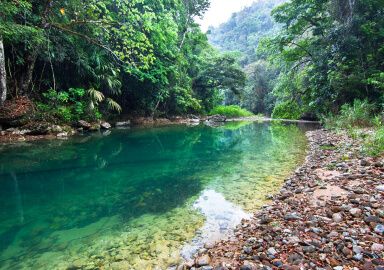Bonefish
Found in the warm ocean waters, bonefish is a top target species for saltwater fly-fishing
View 9 listings
9
listings
–
price starting from
6
countries
Where and When?
Bonefish are distributed in many of the warmer marine areas of the world and have become important sport angling species in places such as south Florida, the Bahamas, Hawaii, Mauritius and other oceanic islands. They are generally a fish of shallow sandy or muddy substrates and they favor seagrass beds, mangrove areas and coastal sandbanks.
Bonefish are present in many areas, and can be caught on bait everywhere, but the prime locations for bonefish fishing should have clear water, so that you can catch them by the most popular and exciting method: fly fishing by sight. Wherever they are, they are more often and more easily caught in the warmer months. In places like Florida and the Gulf of Mexico this means April to November while in South Africa (Southern Hemisphere) it is November to April. They are daylight feeders but mornings and latish afternoons are usually the best time to catch them.
About Bonefish
Until recently, there was only one “bonefish” worldwide, Alba vulpes, but scientists have now separated it into several species. From an angling perspective, however, apart from fairly-minor size differences, all species look, feed and act like each other and so may still be treated as one.
Bonefish have the ultimate “torpedo” shape of the body, their noses are pointed and everything is streamlined and hydrodynamic. They are silvery on the sides, darker on top but often with some lateral shading on the flanks that appear to be darker lines. Bonefish have smallish mouths under the front of the head with strong lips but no real teeth. They feed mostly on bottom living invertebrates, such as shrimps, crabs and shellfish, but also eat small fish.
Bonefish can reach a maximum length of about 79 cm. (31 in.) and mass of 6.4 kg. (14 lbs.) with a lifespan of up to 20 years. They mature at 2-3 years and a length of about 43 cm. (17 in.). They are usually solitary and resident with no clear annual migrations.
How to Catch?
Bonefish may be caught using spinning outfits and natural bait, such as crabs and worms but, and some anglers use soft plastics. But most bonefish enthusiasts are fly fishers.
As the species is found in shallow clear water, and is often very easily “spooked”, it is usually best to approach the fishing area on foot. Some excellent shallow areas, such as off Mauritius, are far from land a boat may be necessary to access the area but bonefish are often wary of boats. Approaching a sensitive fish in shallow clear water in strong sunshine is not easy and every effort must be made to use stealth and cast carefully. If this is achieved and a feeding fish is spotted, it is best to establish the direction in which the fish is moving and cast a short distance in front of it and “tweak” the fly gently.
Pound for pound bonefish must be one of the best and strongest fighters. If the fish takes your fly, it will do its very best to get off and, while they rarely jump out of the water, they are usually very reluctant to be landed. Bonefish are very edible but, as the name implies, they do have many bones. The main attraction and what makes them a top target for fly fishers is the difficulty in hooking one and then the amazing fight that even a medium sized bonefish can give.








